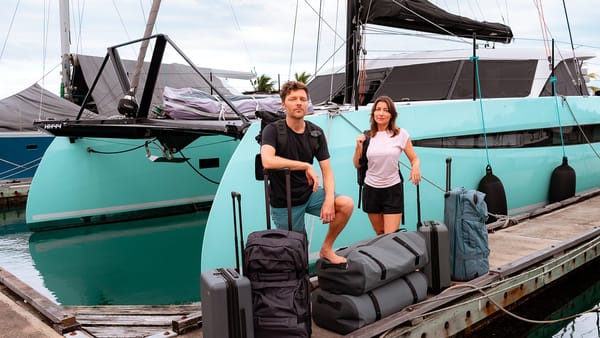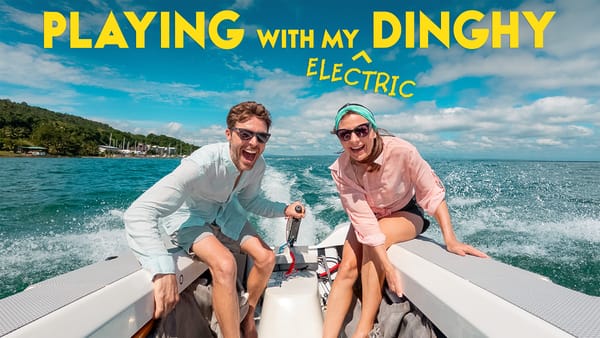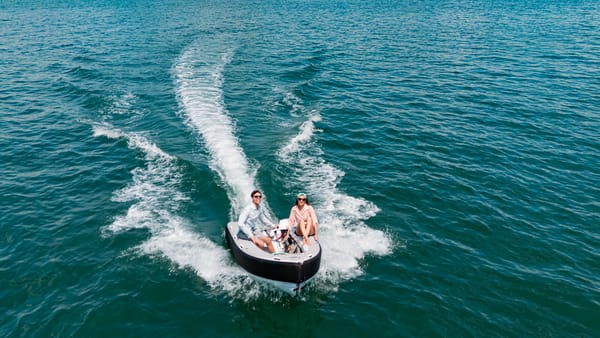Sailboat Solar – Series vs Parallel & Shading

We’re trying to decide on the right solar set up for our new-to-us catamaran. We’ve been told our sailboat solar install will cost a small fortune, so there is no room for errors. Which means it’s time for some informal Wynn testing!
When we conducted our solar panel tilt test in the deserts of California, we noticed the power didn’t change much until we tilted the last of our 6 panels. We thought: What the Heck?!? Shouldn’t we get more power with the tilt of each solar panel? Which lead us to thinking a lot more about how shading affected our solar performance.
Now fast forward six months. Here we are trying to decide on the right solar set up for our sailboat. What worked best for our RV (that can be parked at a specific angle to align perfectly with the sun) might not be the best for our cruising sailboat (that will float and shift around at anchorage depending on the wind and currents). Which poses two questions we need to figure out before we begin our solar planning:
- how to best orient the solar panels because of shading
- decide between parallel or series wiring for our solar install
Series would allow us to run thinner gauge wires which means smaller holes in our boat and less potential for leaks. Less leaking would be a huge plus but that tilt test still sticks in my head and makes me nervous. We know shading could be an issue, but just how much of an issue?
With all my questions back and forth with GoPower! (the maker of our solar panels) and Just Catamarans (the place installing our solar) we decided the best way to wrap our heads around it and be certain, is to test it all! There’s nothing more convincing than seeing it with our own eyes and let me tell you, the results are quite surprising!
We are blown away with the test results. It’s crazy how much shading a single cell diminishes the power output. We’ve always known shading on a solar panel is bad but didn’t understand just how bad it truly is. We also didn’t realize how much more shading affects panel performance in series than it does in parallel. After seeing the results, you might be asking yourself, “why would anyone install solar panels in series”?
The Benefit of Series Wiring
Panels are combined and create higher voltage. Because of the higher voltage, the wires to the charge controller can be a smaller gauge (thinner) and the run can be longer. This is great for going through walls and tight spaces (for example a tiny house or RV).
The Benefit of Parallel Wiring
Each panel works independently. If one panel is shaded, it will not affect the entire solar array. This is great for a sailboat with lots of shadows (from lines, mast, boom, etc.) or a cabin in the woods with varying shadows throughout the day.
What we learned about Shading
Shade is our enemy! If a shadow covers a single cell of a panel we can pretty much kiss that entire solar panel goodbye. This info provides us with an idea of the power we can generate from our solar install on our sailboat. With the unavoidable shading on a sailboat we’ll be lucky if we ever see our solar reach its maximum power potential (which we had no problem achieving with our tiny home on wheels).
Panel Direction Matters
After seeing the results of this test we’ll make sure the solar panels are aligned parallel with the boom and NOT perpendicular. With the shade from the boom, it’s better to have it over one panel and not two. Depending on the size of the shadow the boom casts, it could knock out each panel it covers. Our boom sticks out so far it will likely cover two panels if they were installed perpendicular.
The Solar Solution For Us
Now we know we will wire the panels in parallel and mount them parallel with the boom. Which means we will be able to fit five of our six panels we removed off of the RV across the stern of the boat. That will give us 800 watts of solar plus the 390 watts that the previous owner installed. That’s a whopping 1190 watts of solar!
We’re thinking this should be enough for our power hungry needs, but only time and testing will tell. If we find we need to generate more power in the future, we could add at least 4 flexible panels on the roof of the hardtop. But, if we add that extra power there’s a good chance we’ll need to upgrade our MPPT charge controller.
I’ve researched stackable MPPT controllers and I think that would be our best solution. “Stacking” the controllers allows us to put less panels on each solar controller. Which would help reduce the power loss from shading. But, that is all a little ways out and may not be necessary so, we’ll cross that solar bridge when we get to it.
This test was a real eye opener and learning experience for us, as I’m sure you could see in the video. Until solar panels become more technically advanced to better deal with shading, we will rarely see the maximum performance out of them on our sailboat, which really is a bummer.
If you have your own shading, wiring or solar install story please share it in the comments below. We can all learn from each others discoveries, tests and experience.
Want more details on the solar products we use?
- Check out the “Solar” section in: Our Gear Store
- All things Off The Grid here: https://www.gonewiththewynns.com/living-off-grid-rv-sailboat
Equipment used to film this video:
- Sony A6000: http://amzn.to/1RbUSnx
- Sony Zoom Mic: http://amzn.to/21qHT8B
- Sony 18-105 Lens: http://amzn.to/1oPdcc4
- All of our camera/editing equipment: https://www.gonewiththewynns.com/camera-gear-review-2017
Disclaimer – This test is not perfect and we are not solar experts. We share our experiences and what we learn from them. This is not sponsored nor have we been compensated in any way to share this information.




